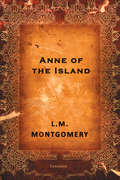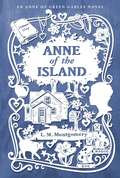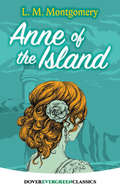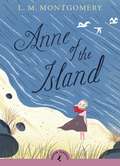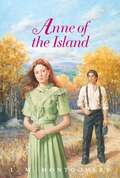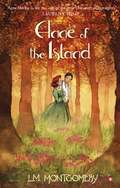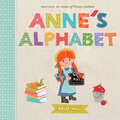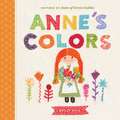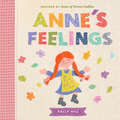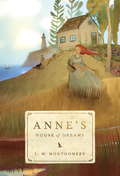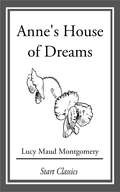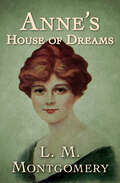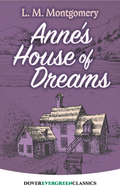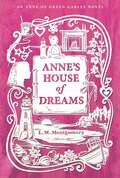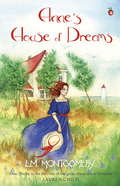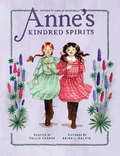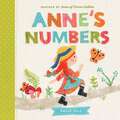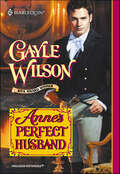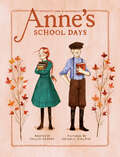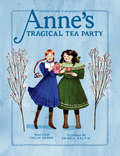- Table View
- List View
Anne of the Island (Anne Of Green Gables Ser. #3)
by Lucy Maud MontgomeryAnne Series Book #3Anne Shirley, the charming red-headed orphan from Green Gables, leaves her beloved Prince Edward Island behind to begin life as a student at Redmond University. And with old friends Gilbert Blythe and Priscilla Grant by her side, Anne is ready to make her mark on the town of Kingsport.But when her bosom friend Diana Barry marries and Gilbert Blythe declares his love, Anne finds herself longing for simpler days.Be it mystery, romance, drama, comedy, politics, or history, great literature stands the test of time. ClassicJoe proudly brings literary classics to today's digital readers, connecting those who love to read with authors whose work continues to get people talking. Look for other fiction and non-fiction classics from ClassicJoe.
Anne of the Island (Anne Shirley #3)
by L. M. MontgomeryAnne Shirley is off to college in this artfully packaged edition of the third book in the Anne of Green Gables series.Anne is finally off to Redmond College! While she's sad to be leaving Marilla and the twins, she's excited to finally become a full-fledged BA, and to embark on new adventures with the other Avonlea folks attending Redmond--a group that includes her friend Gilbert Blythe. At Redmond Anne meets Philippa Gordon, a frivolous but charming girl who pulls Anne into the center of the Redmond social scene. As Anne becomes the object of several boys' affection, she's faced with numerous proposals she can't possibly accept. Then Gilbert ruins everything by declaring his own feelings for her, and Anne worries that she's lost one of her best friends...and possibly so much more. This addition to the renowned Anne of Green Gables series makes a wonderful gift and keepsake.
Anne of the Island (Anne of Green Gables Series #3)
by L. M. MontgomeryAnne of the Island' is the third novel in the "Anne of Green Gables" Series in which she attends Redmond College in Kingsport to study for her BA. Anne is kept up to speed with the goings on in Avonlea via insightful letters and visits home. Her friendship with Gilbert, who has also enrolled at Redmond, blossoms in their new surroundings, but can Anne see it for what it truely is? This early work by Lucy Maud Montgomery was originally published in 1915 and we are now republishing it with a brand new introductory biography. Lucy Maud Montgomery was born on 30th November 1874, New London, in the Canadian province of Prince Edward Island. Her mother, Clara Woolner (Macneil), died before Lucy reached the age of two and so she was raised by her maternal grandparents in a family of wealthy Scottish immigrants. In 1908 Montgomery produced her first full-length novel, titled 'Anne of Green Gables'. It was an instant success, and following it up with several sequels, Montgomery became a regular on the best-seller list and an international household name. Montgomery died in Toronto on 24th April 1942.
Anne of the Island (Dover Children's Evergreen Classics #3)
by L. M. MontgomeryThe impulsive, irrepressible heroine of Anne of Green Gables returns in this third book of the popular series. After two years as the local schoolmarm, Anne's ready for college. Although it's hard to venture away from Prince Edward Island, an exciting world awaits in Nova Scotia, promising the thrills of study and scholarship, adventures with friends old and new, and a dash of romance and heartbreak. Anne's not alone on her journey; Gilbert Blythe, a childhood friend who is in love with Anne, is going to Redmond College, too. Other kindred spirits await on campus, including funny, forthright Philippa Gordon, who shares a darling cottage with Anne and two other chums, their sassy housekeeper, and a spirited stray cat. Four eventful years find Anne writing a prize-winning story, struggling to pay for her education—and perhaps meeting the man of her dreams. She also discovers the true nature of love.
Anne of the Island (Puffin Classics)
by L. M. MontgomeryAnne of the Island is the third heartwarming book about red-haired orphan Anne Shirley.As her childhood friends get married and move away, Anne too leaves Prince Edward Island for college in Kingsport. Although Priscilla Grant and Gilbert Blythe are there, too, she feels lonely and out of place. But Anne soon makes new friends, one of whom is rich, handsome Roy Gardner, whose attentions to Anne make Gilbert very jealous...The book includes a behind-the-scenes journey, including an author profile, a guide to who's who, activities and more..The Puffin Classics relaunch includes:A Little PrincessAlice's Adventures in WonderlandAlice's Adventures Through the Looking GlassAnne of Green Gables seriesBlack BeautyHans Andersen's Fairy TalesHeidiJourney to the Centre of the EarthLittle WomenPeter PanTales of the Greek HeroesThe Adventures of Huckleberry FinnThe Adventures of King ArthurThe Adventures of Tom SawyerThe Call of the WildThe Jungle BookThe OdysseyThe Secret GardenThe Wind in the WillowsThe Wizard of OzTreasure Island
Anne of the Island Complete Text
by L. M. MontgomeryAnne Shirley has come a long way since her days as a mischievous orphan living in the house at Green Gables. She is now eighteen and headed to faraway Redmond College in Kingsport. Anne's college years are sure to be full of fun, but they will also be a time for soul-searching and big decisions. When her longtime friend Gilbert Blythe proposes, Anne feels they can never be more than friends. But is her new admirer, the handsome and wealthy Roy Gardner, really the man of her dreams?
Anne of the Island: Anne Of Green Gables; Anne Of Avonlea; Anne Of The Island; Anne's House Of Dreams (Anne of Green Gables #3)
by L. M. MontgomeryThe third book in the Anne of Green Gables series'All life lessons are not learned at college. Life teaches them everywhere.'At eighteen years old Anne is leaving Green Gables for university - her life's dream. But her feelings are bittersweet: although excited to see the world, she is heartbroken to leave her home and everyone she loves.Anne spends her first days at college lonely and anxious that she doesn't fit in, but before long she has made new friends - including dark, handsome Roy Gardner, who seems to have stepped from her dreams. When her childhood friend Gilbert Blythe finally confesses that his feelings have turned to love, it takes tragedy for Anne to realise what her heart desires.This collection of the best in children's literature, curated by Virago, will be coveted by children and adults alike .These are timeless tales with beautiful covers, that will be treasured and shared across the generations. Some titles you will already know; some will be new to you, but there are stories for everyone to love, whatever your age. Our list includes Nina Bawden (Carrie's War, The Peppermint Pig), Rumer Godden (The Dark Horse, An Episode of Sparrows), Joan Aiken (The Serial Garden, The Gift Giving) E. Nesbit (The Psammead Trilogy, The Bastable Trilogy, The Railway Children), Frances Hodgson Burnett (The Little Princess,The Secret Garden) and Susan Coolidge (The What Katy Did Trilogy). Discover Virago Children's Classics.
Anne's Alphabet (Anne of Green Gables)
by Kelly HillA must-have board book for Anne of Green Gables fans, with charming, hand-embroidered illustrations.Iconic moments from the beloved L.M. Montgomery classic are celebrated in this adorable concept book. Artist Kelly Hill creates vignettes of the most recognizable moments from Anne of Green Gables, including nosy neighbor, freckles, kindred spirits and imagination. Each letter of the alphabet is brought to life through a memorable Anne scene, with simple text and tactile, gorgeous works of art created from cut fabric and embroidery.Part of a series of Anne concept books, Anne's Alphabet is a perfect way to introduce future fans to this winning character.
Anne's Colors (Anne of Green Gables)
by Kelly HillA must-have board book for Anne of Green Gables fans, with charming, hand-embroidered illustrations.Iconic moments from the beloved L.M. Montgomery classic are celebrated in this adorable concept book. Artist Kelly Hill creates vignettes of the most recognizable scenes from Anne of Green Gables, including Anne and Diana's first meeting, Gilbert pulling Anne's hair, Anne's puffed-sleeve dress and even Anne and Diana sharing raspberry cordial! Each scene has its own color, with simple text and tactile, gorgeous works of art created from cut fabric and embroidery.Part of a series of Anne concept books, Anne's Colors is a perfect way to introduce future fans to this winning character.
Anne's Feelings (Anne of Green Gables)
by Kelly HillA must-have board book for Anne of Green Gables fans, with charming, hand-embroidered illustrations.Iconic moments from the beloved L.M. Montgomery classic are celebrated in this adorable concept book. Artist Kelly Hill creates vignettes that showcase Anne's wide array of feelings, including happy, brave and, of course, the depths of despair. Each feeling is brought to life through a memorable Anne scene, with simple text and tactile, gorgeous works of art created from cut fabric and embroidery.Part of a series of Anne concept books, Anne's Feelings is a perfect way to introduce future fans to this winning character.
Anne's House of Dreams
by L. M. MontgomeryGilbert Blythe is finally a doctor, and at long last he and Anne are ready to say their vows. Soon husband and wife will be bound for a new life together in their own house of dreams, on the shores of Four Winds Harbor, near Gilbert's new medical practice in the village of Glen St. Mary. Of course, a new life brings fresh surprises and fresh problems to solve. Anne and Gilbert soon find themselves entangled in the lives of their neighbors, including the lighthouse attendant, Captain Jim, with his sad stories of the sea; Miss Cornelia Bryant, a formidable woman who always speaks her mind; Owen Ford, who longs to write the Great Canadian Novel; and the tragically beautiful Leslie Moore, to whom Anne grows closer when her own perfect life is touched by heartbreak.
Anne's House of Dreams
by Lucy Maud MontgomeryThis anthology is a thorough introduction to classic literature for those who have not yet experienced these literary masterworks. For those who have known and loved these works in the past, this is an invitation to reunite with old friends in a fresh new format. From Shakespeare s finesse to Oscar Wilde s wit, this unique collection brings together works as diverse and influential as The Pilgrim s Progress and Othello. As an anthology that invites readers to immerse themselves in the masterpieces of the literary giants, it is must-have addition to any library.
Anne's House of Dreams (Anne Shirley #5)
by L. M. MontgomeryAnne's own true love, Gilbert Blythe, is finally a doctor, and in the sunshine of the old orchard, among their dearest friends, they are about to speak their vows. Soon the happy couple will be bound for a new life together and their own dream house, on the misty purple shores of Four Winds Harbor. A new life means fresh problems to solve, fresh surprises. Anne and Gilbert will make new friends and meet their neighbors: Captain Jim, the lighthouse attendant, with his sad stories of the sea; Miss Cornelia Bryant, the lady who speaks from the heart -- and speaks her mind; and the tragically beautiful Leslie Moore, into whose dark life Anne shines a brilliant light.
Anne's House of Dreams (Puffin Classics)
by L. M. MontgomeryThe fifth novel about Anne Shirley, the red-haired girl from Green Gables.Life seems perfect to Anne Shirley, about to marry her childhood friend Gilbert Blythe and set up home with him in her 'house of dreams' on the shores of Four Winds Harbor. There are new neighbours to meet and fresh problems to solve. But then tragedy strikes and there's huge heartache for the young couple which takes all of their courage and love to overcome.
Anne's House of Dreams: Annotated Edition (Anne of Green Gables Series #5)
by L. M. Montgomery<p>Anne and Gilbert join in domestic harmony in this artfully packaged edition of the fourth book in the Anne of Green Gables series.<p> <p>Anne is marrying Gilbert Blythe! While she’s deliriously happy to finally be with her version of Prince Charming, she’s devastated when she learns that they will be making their new home miles away from her beloved Avonlea. But Anne is always up for an adventure, especially when she has Gilbert by her side.<p> <p>The newlyweds settle right in to their house of dreams. Anne couldn’t be more content—the house is darling and fits all of her lofty requirements: a bubbling brook running through the property, lots of lovely trees, and close proximity to a beautiful old lighthouse and the sea. In true Anne fashion she immediately makes new friends, including salty Captain Jim, beautiful but tragic Leslie Moore, and prim and proper Miss Cornelia Bryant.<p> <p>While Anne’s days are filled with triumphs and tragedies, her imagination, spirit, and sense of humor guide her as she navigates this next chapter in her extraordinary life.<p>
Anne's House of Dreams: Annotated Edition (Dover Children's Evergreen Classics #5)
by L. M. MontgomeryIn this fifth book of the Anne of Green Gables series, our red-haired heroine finally marries her childhood sweetheart and true love, Gilbert Blythe. After a ceremony in the sunshine of the old orchard at Green Gables, surrounded by the loving faces of long-familiar friends, the young doctor and his bride set off for the mist-shrouded shores of Four Winds Harbor.The newlyweds settle in a quaint fishing village, where their snug home offers views of the sea from every window. The new setting provides a fresh opportunity for Anne to discover kindred spirits: lighthouse keeper Captain Jim, teller of enchanting tales; bitter-tongued but kind-hearted Miss Cornelia, who bears an enduring grudge against men and Methodists; fascinating Leslie Moore, trapped in a loveless marriage, who envies and admires Anne; and writer Owen Ford, who seeks inspiration for his great Canadian novel. Poignant, romantic, and brimming with old-fashioned charm, Anne's House of Dreams traces the beloved heroine's path to maturity.
Anne's House of Dreams: Large Print (An Anne of Green Gables Novel)
by L. M. MontgomeryAnne and Gilbert join in domestic harmony in this artfully packaged edition of the fourth book in the Anne of Green Gables series.Anne is marrying Gilbert Blythe! While she's deliriously happy to finally be with her version of Prince Charming, she's devastated when she learns that they will be making their new home miles away from her beloved Avonlea. But Anne is always up for an adventure, especially when she has Gilbert by her side. The newlyweds settle right in to their house of dreams. Anne couldn't be more content--the house is darling and fits all of her lofty requirements: a bubbling brook running through the property, lots of lovely trees, and close proximity to a beautiful old lighthouse and the sea. In true Anne fashion she immediately makes new friends, including salty Captain Jim, beautiful but tragic Leslie Moore, and prim and proper Miss Cornelia Bryant. While Anne's days are filled with triumphs and tragedies, her imagination, spirit, and sense of humor guide her as she navigates this next chapter in her extraordinary life. This addition to the renowned Anne of Green Gables series makes a wonderful gift and keepsake.
Anne's House of Dreams: Large Print (Anne of Green Gables #5)
by L. M. MontgomeryThe fifth book in the Anne Shirley series.'They belonged to each other; and, no matter what life might hold for them, it could never alter that. Their happiness was in each other's keeping and both were unafraid'There has never been a wedding at Green Gables - that is, until now. In the old orchard, on a perfect sunny day, surrounded by their dearest friends, Anne Shirley and Gilbert Blythe are married at last.The couple begin their new life together far from Avonlea, at Four Winds Harbour, where Gilbert has found the perfect home - a little white house on the shore, overlooking the sea. Before long, they have made new friends: Captain Jim, the lighthouse keeper; indomitable Miss Cornelia Bryant, who always speaks her mind; the writer Owen Ford; and beautiful Leslie Moore, whose sad life has led her to bitterness. When Anne and Gilbert face their own tragedy, they will need all their courage, and the support of their friends, to help them through.This collection of the best books in children's literature, curated by Virago, will be coveted by children and adults alike. These are timeless tales with beautiful covers that will be treasured and shared across the generations. Some titles you will already know; some will be new to you, but there are stories for everyone to love, whatever your age. Our list includes Nina Bawden (Carrie's War, The Peppermint Pig), Rumer Godden (The Dark Horse, An Episode of Sparrows), Joan Aiken (The Serial Garden, The Gift Giving) E. Nesbit (The Psammead Trilogy, The Bastable Trilogy, The Railway Children), Frances Hodgson Burnett (The Little Princess,The Secret Garden) and Susan Coolidge (The What Katy Did Trilogy). Discover Virago Children's Classics.
Anne's Kindred Spirits: Inspired by Anne of Green Gables (An Anne Chapter Book #2)
by Kallie GeorgeThe sweet and funny second book in a new early-reader series, starring the spirited and outspoken Anne Shirley as she makes friends and settles into life at Green Gables -- with a few hijinks along the way, of course!Anne is nervous and excited to meet Diana, a neighbor girl who she just knows will be a kindred spirit. She's even more excited when she learns that she's invited to her very first picnic! Until Marilla's precious brooch goes missing and it looks like it's Anne's fault. That is, Marilla is upset and Anne's picnic adventure is now in jeopardy. Ultimately, the misunderstanding with the brooch is resolved and Anne is able to go to the picnic. Anne and Diana's friendship blossoms and Anne's bond with Matthew and Marilla grows stronger.Lovingly adapted by Kallie George with beautiful nostalgic illustrations by Abigail Halpin, this series is perfect for fans of Anne, new and old.
Anne's Numbers (Anne of Green Gables)
by Kelly HillA must-have board book for Anne of Green Gables fans, with charming, hand-embroidered illustrations.Iconic moments from the beloved L.M. Montgomery classic are celebrated in this adorable concept book. Walk along with Anne as she goes on a nature walk, counting trees, flowers, clouds and friends! The path Anne takes is based on the description of Anne's walk to school in Anne of Green Gables. Each scene has multiple counting opportunities, with simple text and tactile, gorgeous works of art created from cut fabric and embroidery.Part of a series of Anne concept books, Anne's Numbers is a perfect way to introduce future fans to this winning character.
Anne's Perfect Husband
by Gayle WilsonMajor Ian Sinclair knew firsthand that war made men do strange things. But to be named guardian of the daughter of the man responsible for ending his career-and very nearly his life?-was beyond the Pale. Yet now Anne Darlington was his responsibility, and he found himself longing for a future he'd thought he no longer believed in...Cloistered in a remote boarding school,Anne Darlington had grown up never knowing any other life. Until fate thrust her into the strong arms of Ian Sinclair, a tortured nobleman whose secret connection to her father threatened her unspoken dream that Ian would someday return her love...and become her perfect husband.
Anne's School Days: Inspired by Anne of Green Gables (An Anne Chapter Book #3)
by Kallie GeorgeThe third book in an early-reader series inspired by Anne of Green Gables, starring the spirited Anne Shirley as she navigates her first days of school and the incorrigible Gilbert Blythe.Anne loves autumn in Avonlea, and she's been enjoying her first three weeks of school. It helps that she walks to school with and sits next to her kindred spirit, Diana Barry. However, one day, Gilbert Blythe joins the class. According to Diana, he's very handsome, and smart too. However, Gilbert immediately gets on Anne&’s nerves. When he pulls on Anne&’s braid and calls her &“Carrots&” because of her red hair, enough is enough. How can Anne enjoy school when Gilbert is ruining everything? Anne vows never to talk to Gilbert again, and even stops going to school for a time when her teacher forces Anne to sit next to her rival. But later, when Anne has an accident on the pond and her wooden plank sinks, who should come to her rescue but her nemesis, Gilbert Blythe?Lovingly adapted by Kallie George with beautiful nostalgic illustrations by Abigail Halpin, this series is perfect for fans of Anne, new and old.
Anne's School Days: Inspired by Anne of Green Gables (An Anne Chapter Book)
by Kallie GeorgeThe third book in an early-reader series inspired by Anne of Green Gables, starring the spirited Anne Shirley as she navigates her first days of school and the incorrigible Gilbert Blythe.Anne loves autumn in Avonlea, and she's been enjoying her first three weeks of school. It helps that she walks to school with and sits next to her kindred spirit, Diana Barry. However, one day, Gilbert Blythe joins the class. According to Diana, he's very handsome, and smart too. However, Gilbert immediately gets on Anne&’s nerves. When he pulls on Anne&’s braid and calls her &“Carrots&” because of her red hair, enough is enough. How can Anne enjoy school when Gilbert is ruining everything? Anne vows never to talk to Gilbert again, and even stops going to school for a time when her teacher forces Anne to sit next to her rival. But later, when Anne has an accident on the pond and her wooden plank sinks, who should come to her rescue but her nemesis, Gilbert Blythe?Lovingly adapted by Kallie George with beautiful nostalgic illustrations by Abigail Halpin, this series is perfect for fans of Anne, new and old.
Anne's Tragical Tea Party: Inspired by Anne of Green Gables (An Anne Chapter Book #4)
by Kallie GeorgeThe fourth book in an early chapter book series inspired by Anne of Green Gables, starring the spirited Anne Shirley as she hosts her very first tea party with her kindred spirit, Diana, to disastrous results.Anne loves having pretend tea parties by herself. She even decorates her room with branches and colorful leaves for the occasion. Marilla Cuthbert, who adopted Anne in the last year, wishes Anne would act a little more sensibly. One day, Marilla comes up with a plan to keep Anne out of mischief -- Anne can host her very own tea party and invite her kindred spirit, Diana Barry! Anne is thrilled, and sets out to host the most lovely and grown-uppish tea party she can muster. But when she makes Diana sick by accidentally giving her the wrong drink, Diana's mother is furious. Can Anne be forgiven? Will she ever be allowed to play with Diana again?Lovingly adapted by Kallie George with beautiful nostalgic illustrations by Abigail Halpin, this series is perfect for fans of Anne, new and old.
Anne's World
by Benjamin Lefebvre Irene GammelThe recent 100 year anniversary of the first publication of L.M. Montgomery's Anne of Green Gables has inspired renewed interest in one of Canada's most beloved fictional icons. The international appeal of the red-haired orphan has not diminished over the past century, and the cultural meanings of her story continue to grow and change. The original essays in Anne's World offer fresh and timely approaches to issues of culture, identity, health, and globalization as they apply to Montgomery's famous character and to today's readers.In conversation with each other and with the work of previous experts, the contributors to Anne's World discuss topics as diverse as Anne in fashion, the global industry surrounding Anne, how the novel can be used as a tool to counteract depression, and the possibility that Anne suffers from Fetal Alcohol Syndrome. Anne in translation and its adaptation for film and television are also considered. By establishing new ways to examine one of popular culture's most beloved characters, the essays of Anne's World demonstrate the timeless and ongoing appeal of L.M. Montgomery's writing.
